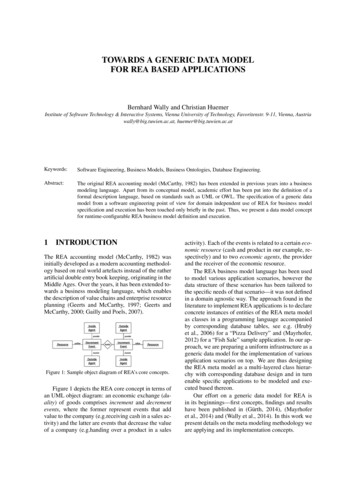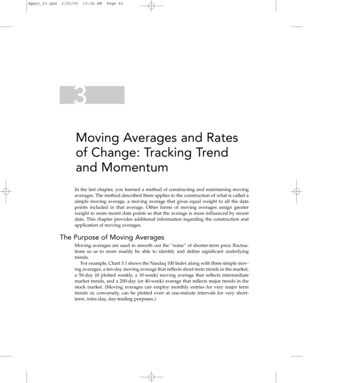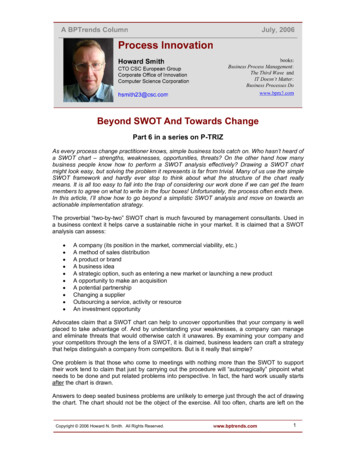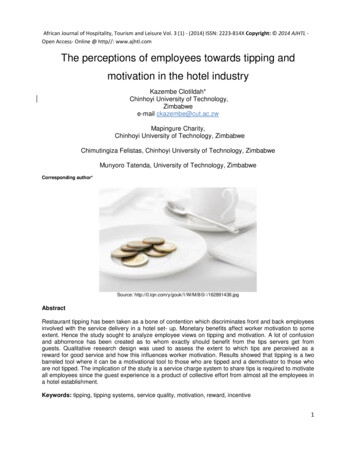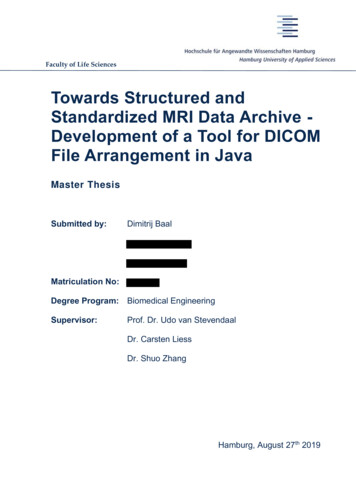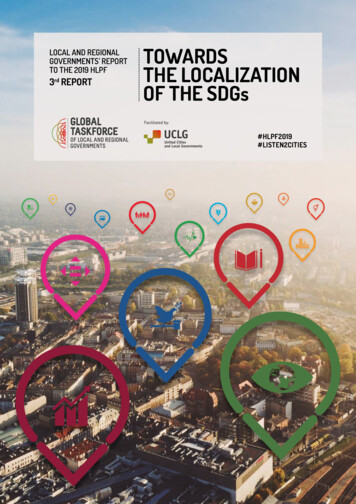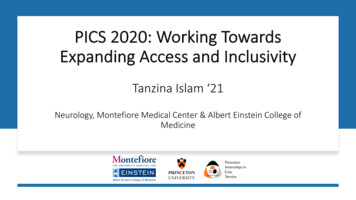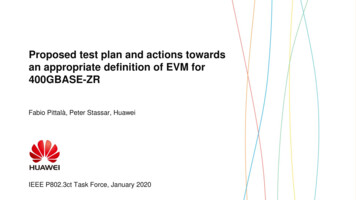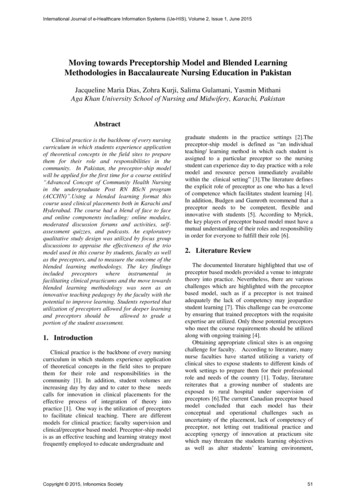
Transcription
International Journal of e-Healthcare Information Systems (IJe-HIS), Volume 2, Issue 1, June 2015Moving towards Preceptorship Model and Blended LearningMethodologies in Baccalaureate Nursing Education in PakistanJacqueline Maria Dias, Zohra Kurji, Salima Gulamani, Yasmin MithaniAga Khan University School of Nursing and Midwifery, Karachi, PakistanAbstractClinical practice is the backbone of every nursingcurriculum in which students experience applicationof theoretical concepts in the field sites to preparethem for their role and responsibilities in thecommunity. In Pakistan, the preceptor-ship modelwill be applied for the first time for a course entitled“Advanced Concept of Community Health Nursingin the undergraduate Post RN BScN program(ACCHN)”.Using a blended learning format thiscourse used clinical placements both in Karachi andHyderabad. The course had a blend of face to faceand online components including: online modules,moderated discussion forums and activities, selfassessment quizzes, and podcasts. An exploratoryqualitative study design was utilized by focus groupdiscussions to appraise the effectiveness of the triomodel used in this course by students, faculty as wellas the preceptors, and to measure the outcome of theblended learning methodology. The key findingsincluded preceptors where instrumental infacilitating clinical practicums and the move towardsblended learning methodology was seen as aninnovative teaching pedagogy by the faculty with thepotential to improve learning. Students reported thatutilization of preceptors allowed for deeper learningand preceptors should beallowed to grade aportion of the student assessment.1. IntroductionClinical practice is the backbone of every nursingcurriculum in which students experience applicationof theoretical concepts in the field sites to preparethem for their role and responsibilities in thecommunity [1]. In addition, student volumes areincreasing day by day and to cater to these needscalls for innovation in clinical placements for theeffective process of integration of theory intopractice [1]. One way is the utilization of preceptorsto facilitate clinical teaching. There are differentmodels for clinical practice; faculty supervision andclinical/preceptor based model. Preceptor-ship modelis as an effective teaching and learning strategy mostfrequently employed to educate undergraduate andCopyright 2015, Infonomics Societygraduate students in the practice settings [2].Thepreceptor-ship model is defined as “an individualteaching/ learning method in which each student isassigned to a particular preceptor so the nursingstudent can experience day to day practice with a rolemodel and resource person immediately availablewithin the clinical setting” [3].The literature definesthe explicit role of preceptor as one who has a levelof competence which facilitates student learning [4].In addition, Budgen and Gamroth recommend that apreceptor needs to be competent, flexible andinnovative with students [5]. According to Myrick,the key players of preceptor based model must have amutual understanding of their roles and responsibilityin order for everyone to fulfill their role [6].2. Literature ReviewThe documented literature highlighted that use ofpreceptor based models provided a venue to integratetheory into practice. Nevertheless, there are variouschallenges which are highlighted with the preceptorbased model, such as if a preceptor is not trainedadequately the lack of competency may jeopardizestudent learning [7]. This challenge can be overcomeby ensuring that trained preceptors with the requisiteexpertise are utilized. Only those potential preceptorswho meet the course requirements should be utilizedalong with ongoing training [4].Obtaining appropriate clinical sites is an ongoingchallenge for faculty. According to literature, manynurse faculties have started utilizing a variety ofclinical sites to expose students to different kinds ofwork settings to prepare them for their professionalrole and needs of the country [1]. Today, literaturereiterates that a growing number of students areexposed to rural hospital under supervision ofpreceptors [6].The current Canadian preceptor basedmodel concluded that each model has theirconceptual and operational challenges such asuncertainty of the placement, lack of competency ofpreceptor, not letting out traditional practice andaccepting synergy of innovation at practicum sitewhich may threaten the students learning objectivesas well as alter students’ learning environment,51
International Journal of e-Healthcare Information Systems (IJe-HIS), Volume 2, Issue 1, June 2015ultimately declining the quality of preceptor basedmodel [8].In addition, today, the trend in pedagogy is amove away from the didactic way of teaching suchas lectures, discussion, readings and a move to onlinelearning which facilitates the use of preceptormodels. [9]. The research findings of Zilembo andMonterosso interestingly pointed out that thepreceptor role is considered as making or breaking ofindividual careers [10]. Many models andinnovations can be implemented to improve studentlearning; however preceptor ship enable facilitationfor nurses to grow professionally and build attributeslike confidence and collaboration Studies indicatedthat preceptor based models increase knowledge andskills in students; if every individual in triad assumestheir responsibilities [8, 10]. For example, studentparticipates as active learner, preceptor as competentand experienced, and faculty as collaborator betweentwo of them [8,10].In Pakistan the preceptor-ship model is anemerging model in one of the private universities ofKarachi Pakistan, preceptor-ship model was appliedfirst time for a course entitled “Advanced Concept ofCommunity Health Nursing (ACCHN)” in theundergraduate Post RN BScN program. Using ablended learning format for the first time this courseused clinical placements for student learning both inurban (Karachi) and semi urban (Hyderabad) areasvia the use of preceptors. The clinical objectives arespelt out in Figure 1.1.2.3.1.4.5.6.7.8.9.10.11.Analyze and demonstrated the role of a CHN in theCommunityApply the concepts of community participation andempowerment when addressing the specifichealth/developmental needs of the communityConduct community assessment and diagnosis including theidentification of high risk groups, utilizingGordon’s Functional Health patterns and the principles ofcommunity participationCollect, interpret, and apply statisticsDevelop and implement action plan relevant to thecommunity’s needEvaluate intervention strategies and modified themanagement plan accordinglyParticipate in field team activities at the Primary Health Care(PHC)/ Family Health Centre (FHC)Identify and utilize available resources and NGO’s workingwith in the community, city, and countryDevelop linkages between the PHC/FHC and thecommunity, city and country for the sustainabilitypurposeAdapt nursing care documentation to the PHC/FHC recordkeeping methods.Complete a community health/development project based onthe needs identified by the community.Figure 1. Clinical Objectives of the AdvanceConcepts of Community Health Nursing (ACCHN)Copyright 2015, Infonomics Society3. MethodsIn this section the study design will be discussed.3.1. Research QuestionThe following two questions guided the study;1.Explore the effectiveness of the preceptorship model in (ACCHN) course in theundergraduate program?2.Describe advantages and disadvantages ofusing blended learning pedagogies inACCHN course?3.2. Study DesignAn exploratory qualitative study design was used.The purpose of exploratory design is to studysomething which has been never explored [11]. Inthis study the researchers are searching for newknowledge, new insights, new understanding and newmeaning. The preceptor-ship model has beenintroduced for the first time in ACCHN course inPakistan; therefore, authors are contextuallyexploring its effectiveness, strength, challenges,advantages and disadvantages within Pakistan [12,13].3.3. Study SamplePurposive sampling is utilized in this study. Thegoal of purposive sampling is to collect informationspecific cases [12]. The purposefully selectedinformants are the ones that are selected specificallyto answer the research questions and that can benefitthe study [13]. The reason for purposive sampling isto deliberately select the study participants to providemeaningful views of the desired perspective.Efforts were made to obtain a representativeheterogeneous sample of faculty, preceptors andstudents. The target population was four AKUSONAM faculties who taught in ACCHN course toyear II Post RN BScN students in Karachi campusduring the semester between January – May 2013. Inaddition, 09 students and 06 preceptors wereinterviewed through focus group discussions. Thestudy was approved by the Aga Khan Universityethics research committee (ERC). The financialsupport for this study came from a Blended Learninggrant which was received by School of Nursing.The interview guide for the focus group wasdeveloped by the researchers based on the literaturereview related to preceptor ship model. Theinterview guide was piloted on four students whowere not participating in the study. The pilot testing52
International Journal of e-Healthcare Information Systems (IJe-HIS), Volume 2, Issue 1, June 2015ensured validity and reliability of interview tool.Additionally, it provided an opportunity to assesshow well the participants understood the questions inthe guide. Focus group discussions were conductedwith the help of interview guide. The semi-structuredinterviews were used to collect the data. Each focusgroup lasted for approximately 45-60 minutes. Inaddition, student and preceptor evaluation formswere used to substantiate the data. Qualitative datafrom the focus group discussions was analyzedmanually.4. Finding and DiscussionIn this section, findings from faculty, preceptor,and student will be explored. In addition, feedback ofthe use of blended pedagogies will be discussed.4.1. Findings from FacultyThe key findings from faculty are that utilizationof preceptors are indeed an innovative way of doingclinical. The preceptors provided opportunities forhands on experience to the students in the realsetting. Additionally, students were involved inindependent sustainable projects, as well receivedopportunities for participation in communitypartnerships with stakeholders. Faculty strongly feltthat introductory workshop with the preceptor atbeginning of the course was very helpful as they weregiven awareness about student objective andassessment criteria, and clinical expectation.However, faculty reported the need for ongoingpreceptor ship training. Preceptors selected werehighly experienced in their own clinical areas andcommunities. The salient feature according to facultywith regards to preceptorship model was rapportbuilding in the community facilitated by thepreceptors. However, faculty stressed that thepreceptors needs to be involved in the grading andassessment of students clinical. With regards tolimitations some of the preceptors had lessqualification but they made it up by their years ofexperience. Similarly, Bilay and Mirick endorsed thatthis model has its limitation and difference of opinionand hesitation voiced up by academician such as lackof content expert, lack of acquaintance withcurriculum as few of the major challenges ofpreceptor based model [2]. Manyon also echoed thatpreceptors need to be experienced, exhibit ocialization among students [14]. Additionally,preceptor based models may fail if preceptors havetime management issues, or lack knowledge andexperience. Study emphasized that student learns alot when preceptors are experienced [10].Copyright 2015, Infonomics Society4.2. Findings from PreceptorThe findings from the preceptors included a twoway learning process. Some of the preceptorsreported their own knowledge base increased. Also,due to their own work responsibilities they reportedthat at times student learning was compromised. Thepreceptors reported that they should be involved inthe grading of the student. The preceptors added thatthe initial workshop was beneficial. However, theyfelt the need for ongoing training. Moreover, theyalso felt overwhelmed as student’s theoreticalknowledge was immense. However, reciprocallypreceptors provided hand on experience in theclinical field.While, describing the strengths of this preceptormodel one of the major advantages was the activecommunity participation in the entire project. Thepresence of the students was vivid as studentsengaged themselves in the community. SimilarlySpouse 2011 also endorsed that effective training ofpreceptors needs to take place to ensure quality andbridge the theory practice gap [7]. Billay and Myrick2008 also reiterate the need for ongoing training andcontinuous feedback for the sustainability of thepreceptorship model to have better outcomes [2].One major limitation pointed out by the preceptorswas the time duration. The preceptors strongly felt ifmore time was allocated more sustainable resultscould have been achieved. Lastly, the preceptors feltchallenged by the prevailing geo political conditionsand so ensured students’ safety by accompanyingthem or having a member of the health team presentwith students at all times in the community.4.3. Findings from StudentsThe students reported that the preceptors are aninvaluable resource, were helpful and facilitated theirlearning. They reported that the preceptors were thegatekeepers to the community. Students appreciatedthe preceptorship model as an innovative way ofteaching pedagogy. However, students’ reported theworkload of the preceptors often resulted in a delayto provide students with ongoing feedback on theirprojects. Students felt they had made a substantialcontribution to the community and had a sense ofownership via their clini
Gordon’s Functional Health patterns and the principles of community participation 4. Collect, interpret, and apply statistics 5. Develop and implement action plan relevant to the community’s need E v alu t einter n io sra g dmodif th management plan accordingly 7. P artic ip t en f ld ea mac v s th ryHealth Car (PHC)/ Family Health Centre (FHC) I dentify anut ilz v bl re source NGO .


